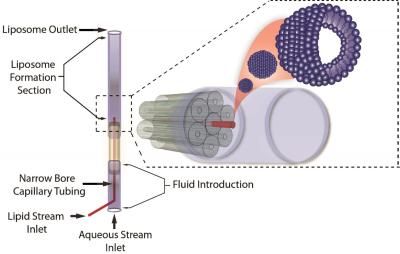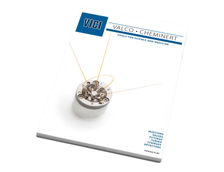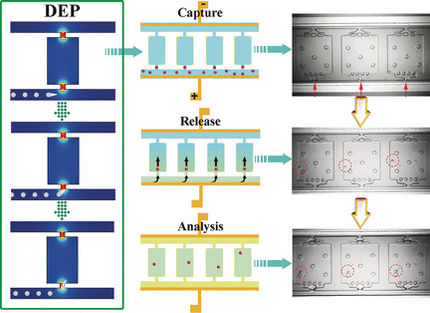Capillary device significantly improves manufacture of quality liposomes
When the English author Sir Francis Bacon wrote "The world's a bubble" in 1629, it's a safe bet he wasn't thinking about microfluidics. However, for a research team led by scientists at the National Institute of Standards and Technology (NIST), Bacon's words could not be truer. Since 2004, their world has revolved around the development of increasingly sophisticated microfluidic devices to produce liquid-filled "bubbles" called liposomes for potential use as vehicles to deliver drugs directly to cancers and other diseased cells within the body.

This is a schematic of the NIST/University of Maryland 3-D microfluidic hydrodynamic focusing device for manufacturing vesicles known as liposomes. Phospholipids dissolved in alcohol flowing through the center capillary (red) mix with a water-based buffer solution added through the six surrounding tubes. Liposomes are created downstream from the convergence point.
NIST
In an article in Lab on a Chip,* the team from NIST and the University of Maryland (UM) describes a new approach for overcoming these obstacles. The group's novel system is made up of bundled capillary tubes, costs less than a $1 to make and requires no special fabrication technology or expertise, yet consistently yields large quantities of uniform and sturdy vesicles.
Previous NIST/UM microfluidic liposome-generating devices were two-dimensional designs incorporating tiny channels etched into a silicon wafer with the same techniques used for making integrated circuits. Phospholipid molecules dissolved in isopropyl alcohol were fed via a central inlet channel into a "mixer" channel and focused into a fluid jet by a water-based solution added through two side channels. The components blended together as they mixed at the interfaces of the flowing fluid streams, directing the phospholipid molecules to self-assemble into nanoscale vesicles of controlled size.
In the latest NIST/UM advance, the planar structure has been replaced by a three-dimensional microfluidic device. The new liposome generator consists of a 3-millimeter-diameter glass cylinder containing a bundle of seven tiny glass capillary tubeseach a millimeter across, or about the diameter of a pinheadwith one in the center and six surrounding it. A micro-sized plastic capillary (about 500 micrometers in diameter, or the length of an amoeba) is fed through the center tube and extended just beyond the end of the capillary bundle. All of the materials are commercially available at pennies per unit.
The water-based solution (known as PBS) flows through the outer six capillaries while the center channel carries the phospholipid dissolved in alcohol (in production, the PBS would carry a drug or other cargo for the vesicles). A standard glass pipette attached to the end of the microfluidic device improves mixing by concentrating the ratio of water to lipid/alcohol.
Original publication
Most read news
Original publication
R. Hood, D. DeVoe, J. Atencia, W. Vreeland and D. Omiatek; "A Facile Route to the Synthesis of Monodisperse Nanoscale Liposomes Using 3D Microfluidic Hydrodynamic Focusing in a Concentric Capillary Array."; Lab on a Chip, 2014.
Organizations
Other news from the department science
These products might interest you

VICI Jour Katalog 15INT by VICI
The VICI Jour Catalog - Accessories for (U)HPLC and Liquid Handling
Capillaries, Tubing, Fittings, Filters, Safety-Products, Tools and much more

VICI Valco/Cheminert catalogue 70INT by VICI
Valves and accessories for chromatography, FIA, SFE, SFC - request catalog now
Wow, 284 pages packed with clever solutions and hints for system optimization

Get the analytics and lab tech industry in your inbox
By submitting this form you agree that LUMITOS AG will send you the newsletter(s) selected above by email. Your data will not be passed on to third parties. Your data will be stored and processed in accordance with our data protection regulations. LUMITOS may contact you by email for the purpose of advertising or market and opinion surveys. You can revoke your consent at any time without giving reasons to LUMITOS AG, Ernst-Augustin-Str. 2, 12489 Berlin, Germany or by e-mail at revoke@lumitos.com with effect for the future. In addition, each email contains a link to unsubscribe from the corresponding newsletter.





















































